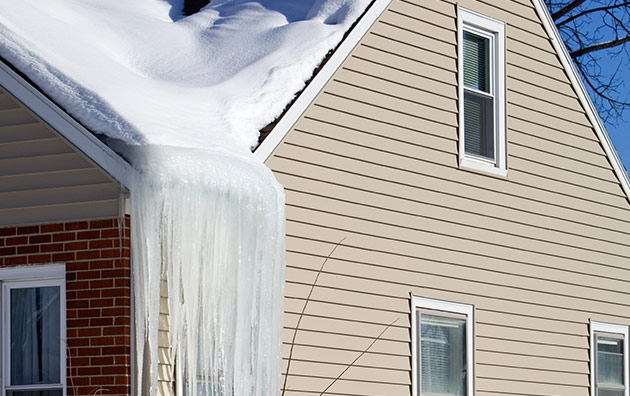
How to Prevent and Identify an Ice Dam?
The coldest winter months in Denver Colorado are December through March. Not only are these months the highest for insurance claims due to frozen pipes bursting, these cold months can also damage your roof if an ice dam develops.
What is an Ice Dam?
This is where water freezes in place at the edge of your roof because the water is not draining properly. The water expands during the freezing process and can force the water/ice to get underneath the roof shingles. This damages the roof material and decking and can lead to water leaking into your home. See below for a picture of an Ice Dam.

Where do Ice Dams Occur?
Ice Dams will develop on the shadiest sides of the home, usually the east and north facing edges of your roof. But, they can occur in other locations depending on the slope and orientation of your roof.
How to prevent an Ice Dam?
- Make sure your roof is properly ventilated and your attic properly insulated.
- After the last leaves have fallen from the trees around your home, make sure to clean your gutters of all debris. This will allow proper water drainage off your roof once the rain and snow start to fall. Also make sure all the connections of your gutters are secure and make sure area around the base of the drain is clear.
- Make sure to inspect the exterior edges of your roof weekly during the cold winter months. Look for areas where the water is not draining properly or is frozen in the gutters around the edges of your roof, particularly.
As moisture accumulates and freezes before it can run off your roof, it will freeze in layers and eventually will get under the roof shingles. This is an ice dam. Also inspect the interior roof of your home and look for water stains. This may be an indication that an ice dam has penetrated the roof membrane.
- Using a ‘roof rake’ clear the edges of your roof of as much snow as possible, taking care not to damage the roof material.
- Place a nylon stocking filled with ‘ice melt’ in your gutters. This will help keep the water moving through the gutters.
- Install heated wiring at the edges of your roof
How to Get Rid of an Ice Dam?
- Hire a professional. There are companies who specialize in removing ice dams by using a heated and pressurized water sprayer to melt the ice
- On a warm day (we do get those in the winter in Colorado), spray the area with warm water from an extra long hose attached to a tap from inside your home. Use caution as the water dripping from the roof can refreeze overnight causing a hazard on the ground around your house. Make sure the gutters are clear and draining the water properly. Do this during the warmest part of the day allowing the water to evaporate.
- Never use any sharp or metal objects to chip away at the ice. This will damage your roof. Always use water, ice melt or plastic tools to remove the ice.
- Removing ice and snow from your roof and surrounding areas can be dangerous. Make sure to use proper safety measures and remember professionals who you can hire are easily found using a Google search in your area.
Is Damage to my Roof or Home Interior covered by Homeowners Insurance?
It depends on the policy and the ‘types of perils covered. A peril is a ‘loss type’.
Here at Denver West Insurance Brokers, we only work with carriers who provide the broadest home insurance coverage. We are a local insurance broker located in Golden, Colorado and serve all of Lakewood, Arvada, Wheat Ridge, Evergreen, Morrison, Littleton, Denver and all of Colorado. Give us a call. We are happy to answer questions your might have.
